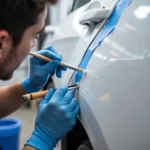Car body filler repair is an essential process in auto bodywork, used to fix dents, scratches, and other imperfections before painting. This guide dives deep into the world of car body filler, covering everything from choosing the right product to achieving a professional finish. car body repair filler offers a range of options to suit your specific needs.
Understanding Car Body Filler
Car body filler, also known as body putty or Bondo (a popular brand name), is a two-part polyester resin used to fill and smooth imperfections on car bodies. It’s crucial to understand its purpose: filler is meant to smooth minor surface imperfections, not to rebuild large missing sections or structurally compromised areas.
Choosing the Right Car Body Filler
Selecting the correct filler is essential for a successful repair. Factors to consider include the size and depth of the damage, the type of substrate (metal, fiberglass, plastic), and environmental conditions. best filler for car body repairs provides a helpful comparison of different types. Lightweight fillers are ideal for small dents and scratches, while heavy-duty fillers are better for larger repairs.
Preparing the Surface
Proper surface preparation is key for optimal adhesion. Clean the area thoroughly with wax and grease remover. Sand the damaged area with coarse grit sandpaper to remove any rust, loose paint, and create a rough surface for the filler to grip. Feather the edges of the damaged area to create a smooth transition.
Applying Car Body Filler
Mix the filler and hardener according to the manufacturer’s instructions. Apply the filler in thin, even coats, using a flexible spreader. Overfilling can lead to cracking and difficulty in sanding. car bodywork repairs with upol fibreglass filler offers a detailed guide on using fiberglass filler for more complex repairs.
Sanding and Shaping
Once the filler has cured completely, sand the area with progressively finer grits of sandpaper, starting with coarse grit and working your way up to a fine grit. Use a block sander for even pressure and a smooth finish. Regularly check your work by running your hand over the surface to feel for any remaining imperfections.
Finishing Touches
After sanding, clean the area thoroughly. You may choose to apply a primer before painting to ensure proper adhesion and color match. car body filler for wood repairs discusses specialized fillers for wooden car components, a less common but important application.
“Proper surface preparation is the most overlooked aspect of car body filler repair. Taking the time to properly clean and prepare the surface will ensure the best possible adhesion and a long-lasting repair,” says John Miller, an experienced auto body technician at Miller’s Auto Body Shop.
“Remember, less is more when applying car body filler. Multiple thin coats are always better than one thick coat, which can lead to cracking and uneven curing,” adds Maria Rodriguez, a veteran automotive painter with over 20 years of experience.
Car body filler repair, when done correctly, can restore your car’s appearance and protect it from further damage. car body repair paints fillers offers a wider perspective on car body repair materials. By following these guidelines and choosing the right materials, you can achieve professional-looking results.
FAQ
- How long does car body filler take to dry?
- Can I use car body filler on plastic?
- What grit sandpaper should I use for sanding car body filler?
- How do I prevent car body filler from cracking?
- Can I apply car body filler over rust?
- How thick should I apply car body filler?
- What is the difference between lightweight and heavy-duty car body filler?
Do you have any other questions? Check out our other articles on car repair and maintenance.
Need help with your car body filler repair? Contact us via WhatsApp: +1(641)206-8880, or Email: [email protected]. We have a 24/7 customer support team ready to assist you.

